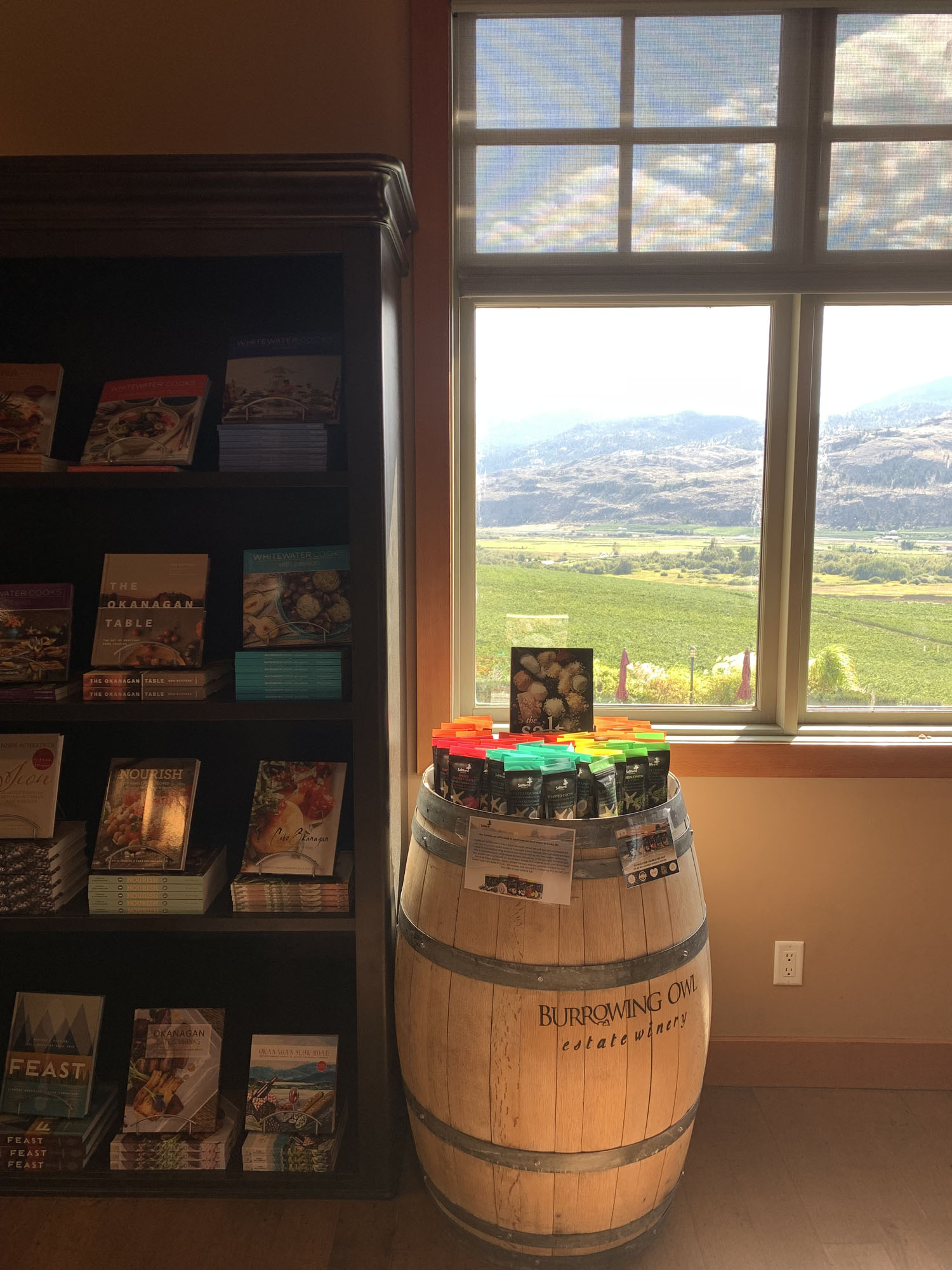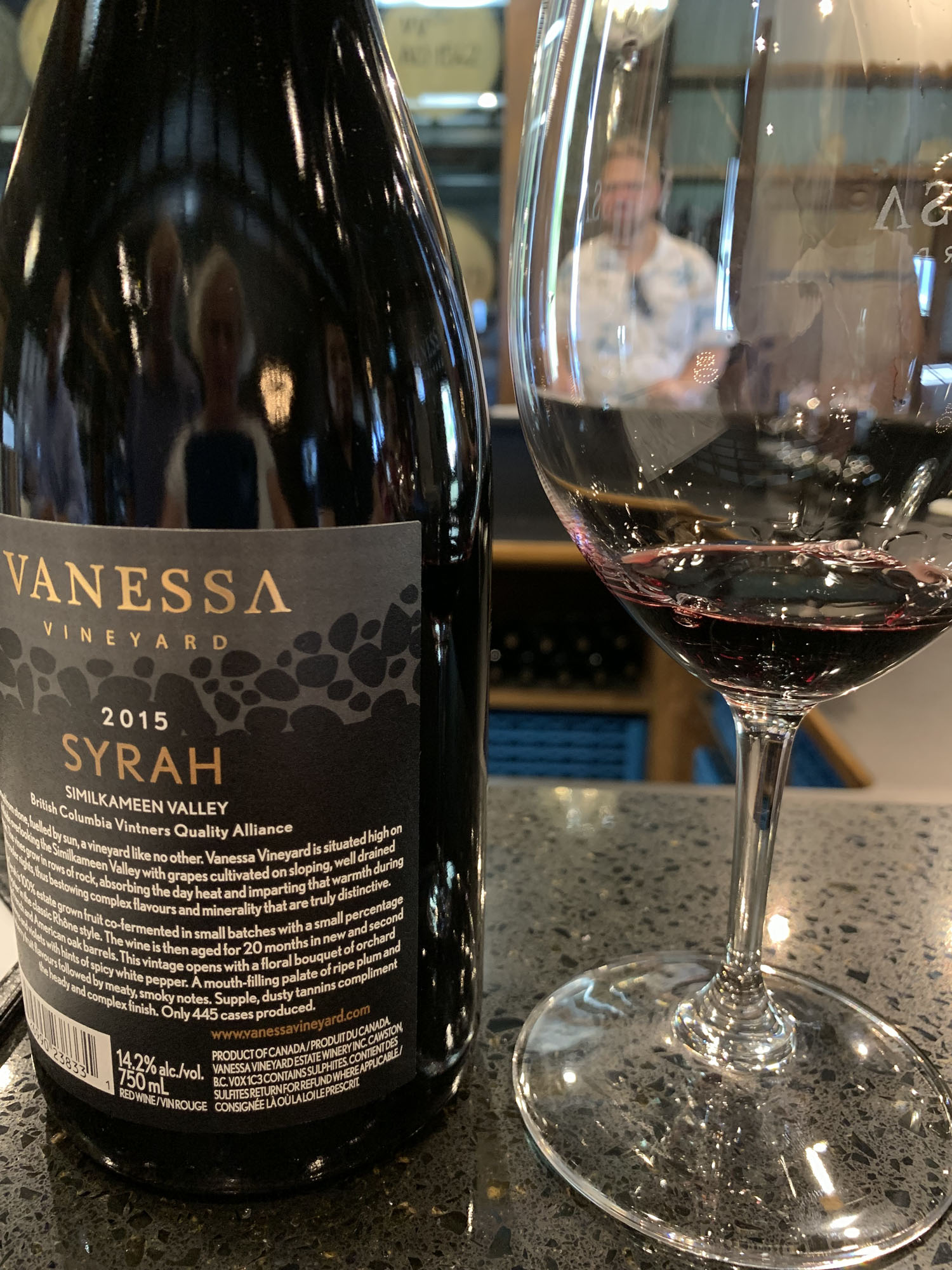My selection of Canada’s Okanagan wineries

Four days in September were perfect for an introduction to Canada’s Okanagan wines. (See my background article on Canada’s western wine gems)
I had a wonderful Vancouver host, Mike, who has explored many of the wineries and their wines over the years, and he had pre-selected some cellars he likes, plus we added a few new ones based on what we read and my desire to skip mass market wineries. In order of our drive, north to south and looping back up through the Similkameen Valley on the west side, here are wineries I enjoyed.
Quail’s Gate, W. Kelowna The location is delightful, above the lake, the wines are very good and the very good (tempting menu) cuisine offers an excellent way to sample for the wines. This is an upmarket winery that has found a good balance between welcoming the public and maintaining some elegance. A handful of guests wandered along the edge of the vineyards next to our lunch table. Wines I liked: The dry white Chasselas-Pinot Blanc-Pinot Gris blend is very well balanced, fruity and refreshing; the Syrah has good depth and the spices I expect from New World Syrahs.







Mission Hill is a large, popular, busy, very much contemporary winery, which has won Canada’s Winery of the Year award five times. It’s in a beautiful hilltop setting, the architecture is classy and the grounds and outdoor sculptures elegant, but it has a kind of split personality for me: the winery for the hoi polloi, with acceptable but not very interesting mass market wines, and the upper class separate tasting bar for very fine but more expensive wines – I had the feeling that money matters more here than in some wineries.
That said, it is worth a visit, certainly for the 12-storey Mission Bell tower with bells made by the extraordinary Paccard Bell Foundry in Annecy. the shop is a souvenir collector’s and travel gift buyer’s delight. My preferred wines from the cheaper tasting bar: Shiraz, Pinot Gris and Riesling.














Gray Monk Estate, Lake Country This is a good wine tourism place, with good professionals pouring the tasting glasses, a winery with respect for tourists and for its own fine wine collection. Events including weddings are clearly a big part of the business model, as seen elsewhere in the region, but the early Austrian winery roots are felt.
Gray Monk takes credit for bringing Pinot Gris to Canada from Alsace more than 45 years ago. It’s become the emblematic white wine here, and Gray Monk does a fine job of it, with its Pinot Gris made from the original, imported plants. The winery still relies on plants brought in from France and Germany, and it has a large, interesting collection of wines that includes Gewürztraminer, Kerner, Ehrenfelser, Pinot Auxerrois. The shop has fun items.








Burrowing Owl – the perfect Canadian winery for me, at the southern end of the Okanagan Valley. Here is what I would hope for from such a winery: quality wines that will sell widely in urban areas yet that reflect the land they come from, in this country where nature takes up considerably more space than people and there is an ancient land-caretaker heritage that is still alive. Burrowing Owl has this; the green, sustainability mindset and educational efforts for consumers are bonuses in my book. Solar is getting a real push here, and there are several electric car charging stations.
The name comes from a delightful local creature that is endangered, and the winery has made it its non-wine mission to help save the little guys; part of every tasting fee goes to their conservation.
The wines are consistently good. My personal favourite was the 2018 Pinot Gris, one of the best I had in the region, crisp and clean, very much pears and green apple aromas for me, but I also really enjoyed the 2018 Sauvignon Blanc, which has plenty of character – although I didn’t find the multitude of aromas the description lists, whew.























Nk’Mip refers to itself as the first indigenous-owned winery in North America. The label doesn’t do credit to an extraordinary history of fighting odds that also includes the first indigenous winemaker in Canada, young Justin Hall in 2017. The winery’s story is told in a series of panels down a side hallway, a tale of the work done by the Osoyoos Indian Band (who live here on a 32,000 acre reserve created in 1877) to mount a viable wine business during a time when alcohol was banned and chiefs were reluctant to produce it on tribal lands.
Visitors should make a point of reading the history, which begins in 1968 – for today’s winery, which opened its doors in 2002. The wines are good quality and the social responsibility towards Band members and the environment are echoed at the other indigenous producers now working in the area. Wines: the Chardonnay is lively and elegant and not surprisingly wins international and national awards. The Syrah had a rich, plummy luscious mouth. The Meritage version (45% Merlot, 35% Cabernet Sauvignon, 10% Malbec, 10% Cab Franc) called Mer’ri’ym is lovely and deep and rich. One to take home. Do opt for the top of the lines wine tasting, in a small separate room.
















Vanessa, where Meritage comes into its own. I confess to falling in love with this wine before visiting this small and very elegant wine operation. Our host served it one night with barbecued meat, on the deck in early autumn in Vancouver, and it was one of those wine moments where fine wine, good conversation and dear friends come together and remind you why wine is such a pleasure.
Very interesting to compare vintages – the 20141 was a gem. Cherry and coffee notes, a hint of licorice. A beautiful wine from one of the Sandhill companies, made by master winemaker Howard Soon who was for decades the top Sandhill wine man – a company with a simple business model, which is to focus on making top-grade small lot reds because the terroir here is perfect for it.
The exemplary wine club is focused on people with some knowledge of wine who appreciate top quality and who realize it isn’t easy to put your hands on Vanessa wines. While Meritage is the leader here, I also appreciated the Cabernet Franc, a grape that doesn’t always work on its own, but this is a good example of it. Silky and fragrant, their word but it works – I found cherries and sage, would not recognize these if I found them, I’m afraid: “Tahitian vanilla, figs and Medjool dates.” Wine descriptions for multicultural guests are … complicated. This is an uncomplicated place to taste wine and you can look closely at the irrigated vines and the scrubby, sagebrush land to understand the wines better.









BC names to love
Part of the fun for a European in the Okanagan area is just reading the New World names of wineries. A sampling: Church & State Wines, Dirty Laundry Vineyard, Oliver Twist, See Ya Later Ranch, Therapy Vineyards, Forbidden Fruit, Hugging Tree, Here’s the Thing, Squeezed, Pipe Dreams, Checkmate and more.
Places to visit another time
Wineries we didn’t have time to cover, but that come recommended or whose stories and locations intrigued me. On my next-time list:
Black Sage – I tried some of these wines elsewhere, was impressed, and I love the extremes of this winery, on the tip of the Sonoran desert. Look for big reds.
Dirty Laundry, intriguing in many ways from the name (old Chinese laundry origins) to its extensive list of 23 wines.
Extinct Volcano, whose wines benefit from an unusual and intriguing volcanic terroir – not just a matter of soil but of higher overnight temperatures and low humidity during the growing season.
Fiftieth Parallel Estate, for the restaurant and award-winning architecture
Indigenous World Winery for its intriguing history that started with a wine shop, and for the wonderful wine names: Here-hee-tel-kin blend, Lap Cheer Charmat method sparkling rosé, Simo red blend with notes of tobacco and anise.
Sandhill, one of the largest, most famous, as well as earliest, with an impressive track record. The location in the centre of Kelowna is less sexy than some, but it makes sense given the size and complexity of production: with five of the best vineyards part of the operation.
See Ya Later Ranch, created by a WWI veteran, at 600 m one of the highest wineries, with the largest planting of Gewürztraminer grapes in N America.
The View, whose owner has created a “flirty red shoe label” which is great fun, and for the overall upbeat tone.
Volcanic Hills, the descriptions of why these wines are different, the impact of volcanic soil and the micro-climate compared to wineries a few short miles away, intrigue me.
And this would still be barely a drop in the BC wine bucket!
[…] See also: My Okanagan Winery Picks […]